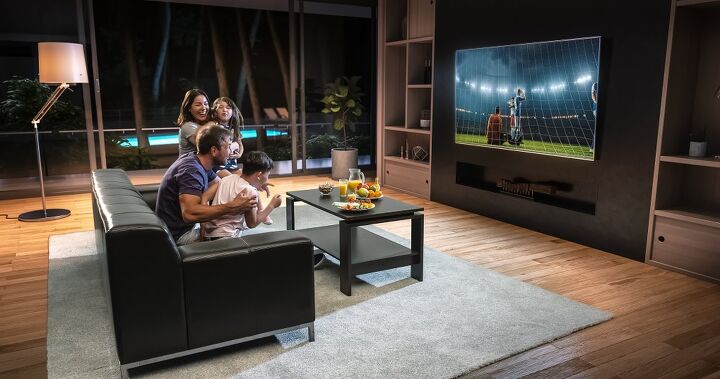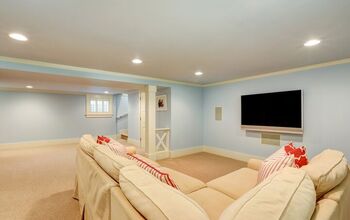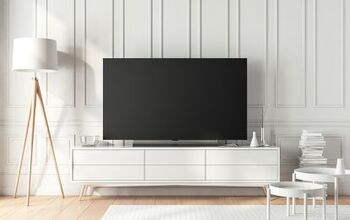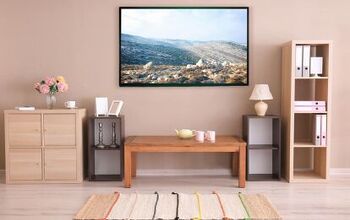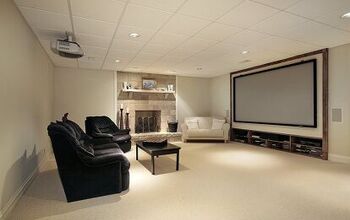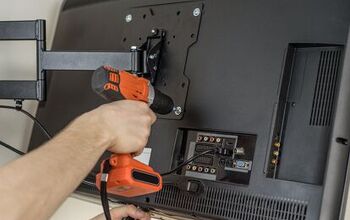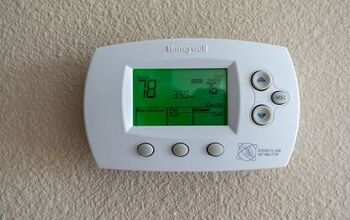65-Inch TV Dimensions (with Photos)

Quite often, the television becomes the focal point in a room, especially family rooms and living rooms. People also often keep televisions in their bedrooms, and nowadays, even kitchens and bathrooms. The main TV in the home is usually large, and it’s essential to choose the right size for the space.
A 65″ TV measures 56.7″ in width by 31.9″ in height. If measuring in cm, the TV will measure 144 cm wide by 81 cm in height. It is recommended to position your 65″ TV at least 8.9′ away for regular use and 6.5′ for cinema use. This will ensure the correct field of view for a good viewing experience.
Things to Consider When Buying a 65-Inch TV
There are several things to consider before purchasing a television. You should consider size, resolution, TV position, room size, room type, and price.
TV Size
The size of your television screen is an essential factor when purchasing a new TV. But, since you measure screen size diagonally, remember, a 65-inch TV doesn’t mean you get 65 inches of viewing space.
Instead, you’ll get about 1,881 square inches of screen area from a TV that is about 57 inches by 33 inches. Different people prefer different sized televisions, but you may need a larger TV if you entertain often.
As an example, this Samsung 65-inch Q90 television measures approximately 36.3 inches tall by 57.1 inches wide. However, the height includes the stand; the actual screen is roughly 32.7 inches tall.
It’s also a slim 1.6 inches deep, which is another important consideration when determining where your TV will go.
TV Resolution
Another vital consideration is the television’s resolution. High-resolution televisions offer more pixelation, which delivers a less grainy picture when you sit close.
Most televisions come in either 4K or 1080p. You might also hear 1080p TVs called Full HD televisions. Today, 4K televisions, or Ultra HD TVs, feature a resolution roughly four times higher than 1080p TVs.
You can even find televisions that are 8K, but they tend to be expensive with little 8K content available. Therefore, for now, 4K is likely more than enough if you want a superior picture.
TV Position
You can either place your television on a TV stand or entertainment center or mount it on the wall. It depends on how you prefer to view the TV as well as the available space in your room.
If you have ample floor space and need storage, then you might prefer a TV stand. However, keep in mind that your TV console should be wider than your television.
A good rule of thumb is for the surface your televisions is on to be at least two inches wider than your TV. Therefore, you should have at least one inch of space on each side of your TV.
For a 65-inch TV that is about 57 inches wide, you would need a TV stand at least 59 inches wide. You can go larger with your TV stand, of course, but don’t go too big. If your TV stand is significantly larger than your television, it could make your TV appear smaller.
TV Price
Of course, price varies significantly among television, depending on size, brand, and other features. Also, TVs with higher resolutions will come with a higher price tag. Know your budget before you start shopping around, and make a list of your must-haves and your nice-to-haves.
Smaller televisions may only cost you about $150 to $200. However, larger TVs, like a 65-inch television, can start to creep past $600 or more. Of course, smart TVs and those with lots of bells and whistles will easily cost upward of $1,200 or more.
But, if you know that you won’t use a lot of the extra features, look at other options and select a television that works best for you. You don’t want to end up paying extra for things you won’t end up using.
The Best Height for Your Television Stand
You also need to consider the TV stand’s height, as it will affect the viewing quality. Ensure the middle of the television is about eye level to the average viewer watching TV.
To determine optimal TV stand height, measure from the floor to the viewer’s eye level in your home. Ensure the person is seated where most viewing happens, most likely a sofa or chair across from the TV. Subtract half the TV’s height from this number. The height of your TV stand will fall within an inch or two of the resulting figure.
Make sure to account for the depth of the TV stand as well. If you have a smaller living room, a TV stand may take up too much floor space.
Wall-Mounted Televisions
In contrast to a TV stand, a wall-mounted TV can free up a lot of precious floor space. Wall mounting a television takes away the need for an extra piece of furniture in the room.
But, a wall mount can increase viewing distance by a foot or two. This is because placing it on the wall puts it further away than if it was on a TV stand. You’ll also likely end up with a slight viewing angle when the TV is on the wall.
How High Should You Mount a 65-Inch Television?
The height you mount your television varies based on the television’s size. If you have a 65-inch TV, mount it roughly 69 inches from the floor to the center of the TV screen.
If you so desire, you can do some math to determine the perfect height for your TV. You’ll need a graphic calculator to do this.
Take the “Tan” of your reclining angle, which is 10-20 degrees, when laying back. Multiply this by the viewing distance from the TV. Add this number to the viewer’s eye level to determine the perfect TV mounting height.
Most wall mounts feature a design that can fit any size television. However, some models won’t be able to hold up the weight of larger TVs. To make sure your television is stable, use a wall mount made specifically for your size TV.
How To Pick The Right TV Size For Your Space
Think About the Room Size for Your 65-Inch Television
Always factor in the size of the room when choosing your television size. If you get a TV that is too small or large, it can look a little off-balance in the space.
For example, a large TV can easily overwhelm a small room. Conversely, a large room can easily swallow up a small TV.
It is also critical to consider how much floor and wall space you have available. Do you have room for a 65-inch TV and stand, or do you need a wall mount? If you don’t have the proper amount of space, are you up for rearranging your furniture to make it work. Remember, if your room is on the smaller side, a wall-mounted TV is a good solution.
Smaller Rooms
For smaller rooms, keep the TV on the smaller side. This includes kitchens, small to average bedrooms, and smaller living rooms.
You really only need a 32-inch TV for these rooms. However, you shouldn’t view these from more than about 4.9 feet away because viewing quality decreases.
Average to Larger-Sized Rooms
For average-sized living rooms and more oversized bedrooms, a 32 to 40-inch TV will work just fine. You can view these TVs from 4.9 to 8 feet away, so there is more flexibility in placement. These TVs are also more likely to offer smart features and other extras compared to a 32-inch or smaller.
For a living room and a large master bedroom, 45 to 55 inches will provide an optimal viewing experience. With this television size, make sure to view from 8 to 10 feet away.
Larger rooms, like a sizable living room or an outdoor patio area, can house 60 to 85-inch TVs. You will just need to increase the distance from the TV as the TV gets larger.
Of course, you can place a larger TV in a smaller room if you can keep the viewing distance optimal. This will help viewers not to strain their eyes.
The Perfect Viewing Distance for a 65-Inch TV
If you decide to purchase a 65-inch TV, consider the viewing distance when determining where you will place it. As discussed above, you can either mount it on the wall or use a TV stand. Whichever you choose, there is an optimal distance to place your TV from the viewer.
To determine where to place your TV, take the diagonal measurement of your TV. Multiply that by 1.5. This gives you the minimum distance you should be sitting away from your TV.
For a 65-inch TV, that is 97.5 inches or 8.125 feet. However, the distance can act as a range.
If you have a 1080p TV, you’ll want to sit farther away, between 8.125 and 13.5 feet. If you have a 4K TV, you can sit closer without the image appearing grainy. You can sit between 5.5 and 8.5 feet from a 4K TV.
If you primarily use your TV to watch movies, place your seating a bit closer to the TV. This will provide you with the closeness a movie theater offers.
Related Questions
How does a 60-inch TV’s screen size compare to a 65-inch TV?
Because TVs are measured diagonally, a 60-inch TV offers slightly less screen size than a 65-inch. It is about 4 inches less in terms of width and 2 inches shorter on average. A 60-inch TV also isn’t as common today as a 65-inch television, so it might be easier to find a 65-inch TV.
How can I make sure I get the right wall-mount for my 65-inch TV?
Thanks to their design, you can mount most flat-screen TVs. But, be sure to check your manual before to be certain. Find “VESA” (Video Electronics Standards Association) and its accompanying number in your manual. Buy a wall mount with the same VESA number to ensure your TV and wall mount match.

Stacy Randall is a wife, mother, and freelance writer from NOLA that has always had a love for DIY projects, home organization, and making spaces beautiful. Together with her husband, she has been spending the last several years lovingly renovating her grandparent's former home, making it their own and learning a lot about life along the way.
More by Stacy Randall



